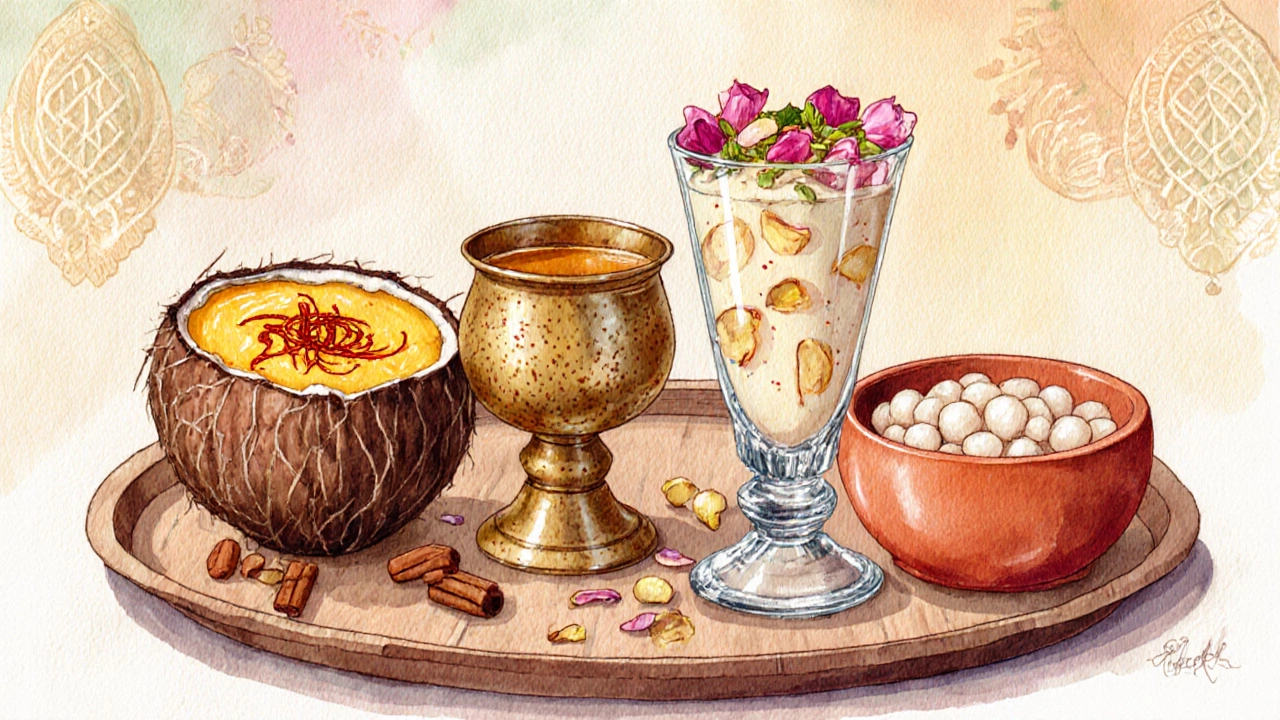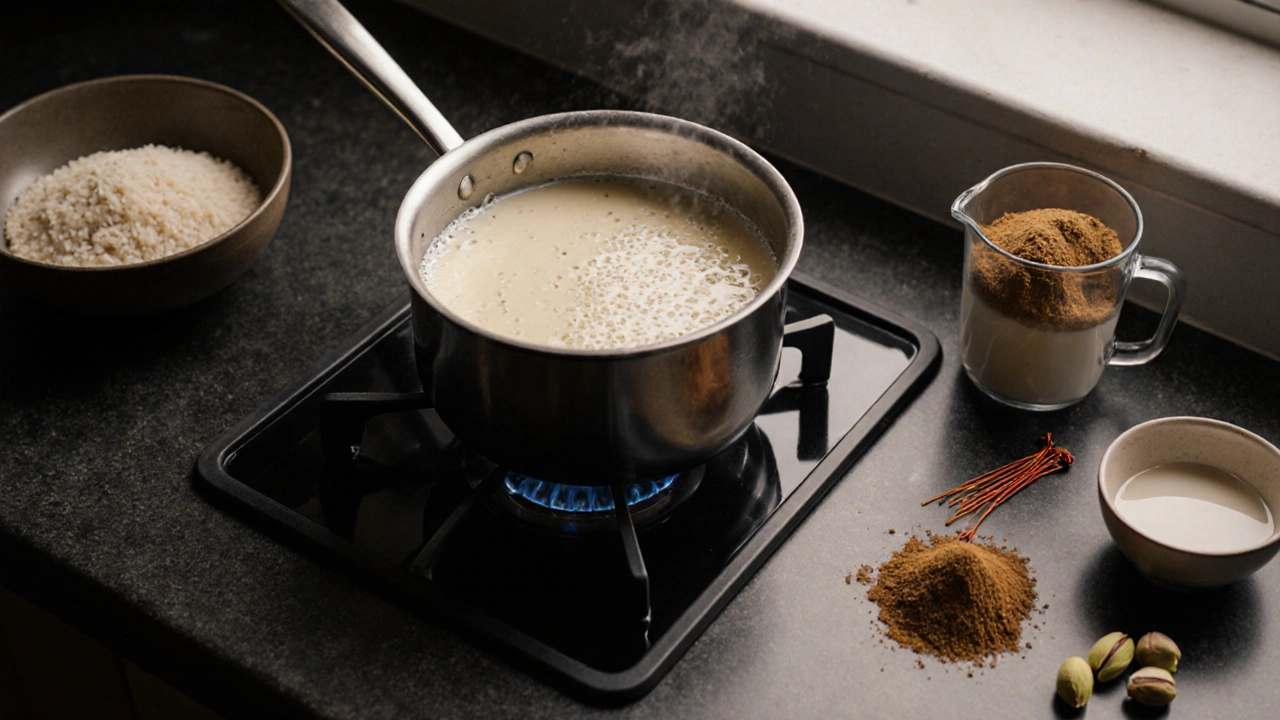Kheer Recipe Calculator
Adjust Kheer Recipe
Key Takeaways
- Kheer, a rice‑based pudding, is widely accepted as the oldest Indian sweet, with mentions in Vedic texts.
- Its simple ingredients-rice, milk, and sugar-allowed it to spread across the subcontinent.
- Regional variations like payasam, payesh, and rice kheer showcase local flavors while keeping the core concept.
- Making authentic kheer at home is easy: just follow the step‑by‑step recipe below.
- A quick comparison table helps you see how other ancient sweets differ in age, main ingredient, and region.
Why Kheer Claims the Crown as the oldest Indian sweet
When you think of Indian desserts, Kheer is a creamy rice pudding that dates back to the Vedic age, making it arguably the oldest Indian sweet. The name itself comes from the Sanskrit word “kshira,” meaning milk, highlighting its dairy‑centric nature. Unlike many later sweets that rely on refined flour or exotic nuts, kheer’s base-just rice, milk, and a sweetener-was readily available to ancient households, which explains its early emergence.
Historical breadcrumbs: Kheer in ancient literature
References to a milk‑based rice dish appear in the Rig Veda (c. 1500‑1200 BCE), where priests offered “kshira‑anna” to the gods. The Atharva Veda mentions a “kheer‑prasad” served after rituals. Moreover, the Ayurvedic text Charaka Samhita lists rice‑milk preparations as digestive aids, reinforcing the idea that kheer was part of daily life, not just a festive treat.
Over centuries, the dish traveled with traders, pilgrims, and chefs, adapting to local tastes. In South India it became “payasam,” in Bengal “payesh,” and in Maharashtra “kheer” retained its name but added coconut milk or jaggery. These regional spins all trace back to the same Vedic prototype.

Regional variations you’ll encounter
- Payasam (South India): Often cooked with coconut milk, cardamom, and sometimes saffron. Lentils or vermicelli replace rice in some versions.
- Payesh (Bengal): Uses Indian rice (short‑grain), thickened with condensed milk, and finished with a drizzle of ghee.
- Badam Kheer (North): Almond paste adds richness; a pinch of rose water gives a floral note.
- Sabudana Kheer (Western India): Tapioca pearls are used instead of rice for a lighter texture during fasting.
All these dishes share three core attributes-grain, dairy, sweetener-making them members of the same culinary family that sprang from the Vedic kitchen.
Simple, authentic Kheer recipe (serves 4)
- Rinse ½ cup of short‑grain rice until water runs clear. Soak for 20 minutes, then drain.
- In a heavy‑bottomed saucepan, combine the rice with 2 cups of full‑fat milk and a pinch of salt. Bring to a gentle boil.
- Reduce heat to low and simmer, stirring occasionally, until the rice is soft and the mixture thickens (≈ 20 minutes).
- Add ¼ cup of powdered jaggery or white sugar, stirring until fully dissolved.
- Flavor with ¼ teaspoon ground cardamom and a few strands of saffron soaked in 1 tablespoon warm milk.
- Finish with 1 tablespoon ghee and a handful of chopped pistachios or almonds.
- Cool to room temperature, then refrigerate for at least 2 hours. Serve chilled or warm, based on preference.
Pro tip: Using a thick‑bottomed pot prevents scorching, and stirring in a figure‑8 motion keeps the milk from forming a skin.

Tips, tricks, and common pitfalls
- Don’t rush the simmer. Patience lets the rice release starch, creating that signature creamy texture.
- For a vegan version, substitute dairy milk with coconut or almond milk and sweeten with jaggery or palm sugar.
- Adjust sweetness at the end; jaggery deepens flavor but can become bitter if overcooked.
- Adding a splash of rose water or kewra extracts after cooking gives an aromatic lift without cooking off the fragrance.
How does Kheer compare to other ancient Indian sweets?
| Sweet | Approx. Origin | Main Grain/Ingredient | Key Region |
|---|---|---|---|
| Kheer / Payasam | ~1500 BCE (Vedic) | Rice + Milk | All of India |
| Halva (sooji / semolina) | ~500 BCE (Mahabharata mentions “shakara‑halva”) | Semolina / Flour | North & West |
| Ladoo (besan or boondi) | ~600 BCE (Puranic texts) | Gram flour / Chickpea flour | All regions |
| Mysore Pak | ~1910 CE (King Krishnaraja Wadiyar) | Gram flour + Ghee | Karnataka |
| Jalebi | ~1300 CE (Persian influence) | Fermented wheat flour | North & Central |
Even though sweets like jalebi and Mysore Pak are beloved, their documented histories begin centuries after kheer’s Vedic debut, reinforcing kheer’s status as the oldest.
Frequently Asked Questions
Is kheer the same as payasam?
Yes, they are regional names for the same milk‑rice pudding. Payasam usually carries a South Indian flair-coconut milk or jaggery-while kheer sticks to cow’s milk and sugar.
Can I make kheer without rice?
You can swap rice for vermicelli (semiya), broken wheat (dalia), or even quinoa for a gluten‑free version. The technique remains the same - simmer the grain in milk until creamy.
What makes kheer suitable for religious offerings?
Its simple, pure ingredients-milk, rice, and sugar-are considered sattvic (pure) in Ayurveda, making it ideal for puja and temple prasad.
How long can homemade kheer be stored?
Refrigerated in an airtight container, it stays fresh for 3‑4 days. Reheat gently, adding a splash of milk if it thickens too much.
Is kheer gluten‑free?
Yes, the classic rice‑milk version contains no wheat or barley. Just ensure any added nuts or flavorings are processed in a gluten‑free facility.
Whether you’re curious about its ancient roots or just want a comforting bowl after dinner, kheer proves that the simplest sweets often have the richest stories.
